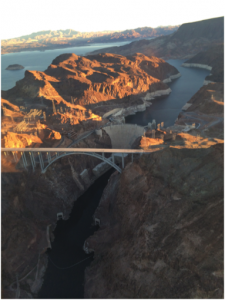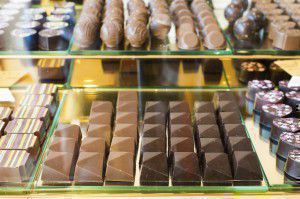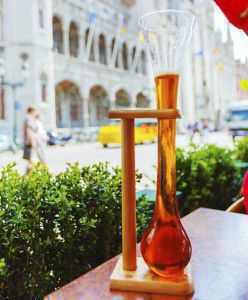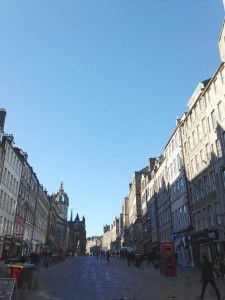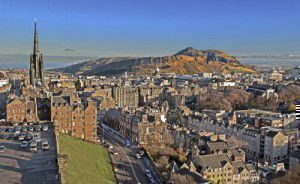Book review: Through the Language Glass
Ever wondered what us language geeks do for fun in our spare time? Reading books about languages, of course! Well, not all the time – but I recently read the very interesting Through the Language Glass by Guy Deutscher, and would recommend it to anyone else who is interested in how different languages work, and how our mother tongue affects our thoughts and behaviour.
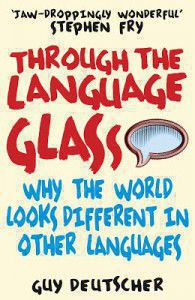 Through the Language Glass is all about the ongoing linguistic debate about whether our native language affects our perception and the way we think about the world around us. A large portion of the book is dedicated to a rather in-depth discussion about the differences between colour vocabulary in various languages. You might already know that Russian and Italian have two words for ‘blue’ (light and dark blue). But you might not know that the famous Greek writer Homer didn’t have any words for blue, and instead used mostly red and black to describe the scenes of the Iliad. This led to a long debate about whether people in the past lacked our modern ‘colour sense’ and saw the world in only a few shades. You’d probably have to be pretty dedicated to trying to understand the evolving debate on the development of linguistic terms for colours to plough through this rather long section, but it is rather interesting if you’ve got the patience.
Through the Language Glass is all about the ongoing linguistic debate about whether our native language affects our perception and the way we think about the world around us. A large portion of the book is dedicated to a rather in-depth discussion about the differences between colour vocabulary in various languages. You might already know that Russian and Italian have two words for ‘blue’ (light and dark blue). But you might not know that the famous Greek writer Homer didn’t have any words for blue, and instead used mostly red and black to describe the scenes of the Iliad. This led to a long debate about whether people in the past lacked our modern ‘colour sense’ and saw the world in only a few shades. You’d probably have to be pretty dedicated to trying to understand the evolving debate on the development of linguistic terms for colours to plough through this rather long section, but it is rather interesting if you’ve got the patience.
The rest of the book moves on to some interesting discussions of smaller tribal languages in Australia and elsewhere, and how their unique features either reflect the requirements of the society/location, or affect the behaviour of the speakers. For example, the Aboriginal language Guuguu Yimithirr has no words for left and right. Instead, speakers must develop an acute sense of North, South, East and West, as it’s impossible for them to say ‘the tree is on my left’ – instead they must say ‘the tree is North of me’. Experiments have shown that even if speakers of the language are driven to new locations blindfolded, they retain their incredible sense of direction and can still describe location based on the compass directions.
And how about grammatical gender? For us English speakers, referring to a table as ‘she’, as a Spanish speaker would (la mesa), or a girl as ‘it’, as a German would (das Maedchen), seems rather odd. But for most Europeans, using a blanket ‘it’ for everything doesn’t really feel right either. So what does this mean for all those speakers of languages with grammatical gender? Do they somehow see a table as girly and feminine, and a phone (el teléfono in Spanish) as macho and masculine? Well of course not… that would be silly! But there may be subtle ways in which these distinctions affect us. Think about how we can tell a story in English being vague about the gender of the person involved. Yesterday, I had dinner with my friend. Whether that friend is male or female is none of your business! But in Spanish, you’re rather forced to disclose that ‘la amiga’ was of course a girl.
We might find the idea of a ‘gender’ for inanimate objects strange and funny, but Deutscher traces this back to at least an original logical starting point. It might surprise you to know that there are many more genders in language, beyond the masculine, feminine and neutral genders you might already know. Some languages even have a ‘vegetable’ gender, which even includes things like aeroplanes. Why, you might ask? Well, it’s simple really. The ‘vegetable’ gender may have started off for only plants. This would have included wood, and anything made from wood, such as a boat, perhaps. It’s then not such a jump to having other vehicles in the same gender.
If any of this sounds intriguing and you’d like to know more, I recommend that you pick up Deutscher’s book. It’s not quite beach reading, but it’s accessibly written, not an academic tome that’s only for linguists. I can guarantee that you’ll learn something new about languages and maybe gain a different perspective on how your native language affects your perception.
Alex
10 reasons to visit… Las Vegas
I was lucky enough to visit one of the most notorious party cities last December; I, however, can not comment on what the night life is like in Vegas as I was only 19 and therefore not allowed to step foot into a bar or club! However, even without the partying there is so much to do in Vegas, as well as lots of places to see. We flew out on the afternoon of Friday 13th, on a plane which contained a lot of nervy people as well as plenty of bachelor and bachelorette parties. We were only there for four days and it was non-stop. Here are my top ten reasons to visit Las Vegas.
1. The Shows
Walking down the strip you can see endless advertising for different shows, concerts and celebrity residences. They all seem that much better over in Vegas; maybe this is because of the additional glitz and flashing lights, or just getting caught up in the buzz of the city. I would highly recommend going to see at least one type of show, as it is a completely different energy and atmosphere.
2. The People
Everyone in Vegas was so friendly. People couldn’t do enough for you, they were always trying to make your experience the best it could be. This didn’t just include staff working in the hotel but everyone on the strip; if people saw you were a group and one was taking a photo of everyone else, someone would always offer to take a group photo of you. People were all so chatty and friendly and even when you were approached by a salesman on the street once you said no they didn’t pester you, they still smiled and said ‘Have a great day’, how often does that happen here in the UK?
3. The Buildings
When watching the films, you expect the strip to go on for miles and miles. However, when you are there it isn’t nearly as long as you expect. Also all of the different styles of buildings you see, ranging from the classic Bellagio to the new styles such as the Wynn. You also have character buildings such as the New York, New York and the Luxor; just viewing them from the outside there is always something different to see.
4. Entertainment
When you are walking along the strip there is always someone or something to see. Ranging from the famous fountains at the Bellagio, to a volcano exploding in front of the Mirage and the pirate show in front of Treasure Islands, which was unfortunately under construction when we were there. There were many different types of people in fancy dress, ranging from Alan in The Hangover to Bumblebee from Transformers, who can actually turn himself from a car to a person! It is simply not possible to walk down the strip and be bored.
5. Casinos
Every hotel has a casino and each one is slightly different. When sitting at a slot machine or one of the numerous machines they have spread throughout the floor, you can really lose track of time. There are no windows and you see people sitting at the tables for hours on end. Often in the morning when you walk through the casino you see people still playing who haven’t left from the night before. Long gone are the days of inserting ‘quarters’ into the machine and pulling the handle; it is now dollar bills and pressing a button. It was rare to find a machine with a handle and it was so exciting when you did find one. Once you are there you can see how people do become addicted; just waiting for the sheet of paper to come out of the machine to tell you how much you have won, and then queuing in anticipation to collect your money. You quickly get into the ‘oh, just one more time’ mind set…
6. Lobbies of Hotels
Each hotel lobby holds something different to entice you in further towards the casinos, restaurants and shops. You want to walk into each hotel and see what they have on show. Most of the hotels were truly spectacular, especially in December where lots had a Christmas theme.
7. Grand Canyon
Undoubtedly one of the most beautiful sights you will ever see. Even if you aren’t there for long, there are various trips you can pick from, ranging from a short helicopter ride over the canyon, to an all-day adventure including having lunch in the canyon. It is a sight you will never forget and you will never see such a vast range of colours anywhere else.
8. The Shopping
An experience I have never had before. In Caesar’s Palace, walking from shop to shop, even though you are inside, you would never know. The ceiling is done in such a way that it feels like you are outside, and even simulates rain and thunderstorms. Or there is the Venetian, with the canal running throughout the ground floor where you can catch a gondola and be serenaded by a gondolier. You won’t experience shopping like this anywhere else in the world.
9. The Chocolate Fountain in the Bellagio
Something you can stand and stare at for hours wondering how it was possible to make – at first it is very hard to tell that it is even real. It is the world’s largest chocolate fountain and took a year and a half in planning and designing alone. For all of the chocolate lovers out there, it is a sight not to be missed.
10. The Food
Every different type of food you could possibly want, you can find in Vegas. The portions are huge, so sharing is definitely recommended if you aren’t overly hungry. At breakfast, when you order pancakes you don’t just get one or three, you get a stack of at least five. Vegas is also renowned for its buffets, where you pay a fixed price and you can go up as many times as you want. These aren’t just any buffets though, they have everything you could possibly want: Chinese, Italian, Seafood… anything and everything.
Even without the partying aspect of Vegas it is still the best city I have ever been to; the list of reasons to go could go on for a very long time.
Have you been to Vegas? What were your best bits?
Amy
10 reasons to visit… Bruges
Have you ever visited a city that managed to change your mind?
I visited Bruges earlier this year. Unfortunately, I’d accidentally timed my visit to coincide with the enthusiastically named ‘Amateur Arts Festival’, and consequently spent Saturday night with tissues rammed in my ears and arms clenching pillows to my head, as my hotel room shook with the relentless noise of amateur bass. I thought then that the chances of coming up with ten reasons to visit Bruges were pretty slim. Yet on Sunday morning, with the loudspeakers in the square finally silenced and the sun out, I became enchanted with this town that everyone always refers to as a peaceful haven of canals. These are the things which managed to turn my opinion around in the space of just one morning.
1. Trains
I get a bit excited about foreign trains, I know, but going to Bruges presented me with a new wonder: the double decker train. True, this is not localised to Bruges alone but most of the IC trains from Bruxelles seemed to be two storeys high, giving a fantastic view of the very flat countryside (and occasional windmill!) from the top deck. The trains are smooth and cool, and the conductors wear an amusing flat cap as part of their uniform. If you’re just planning a short visit to Bruges, you can get the Eurostar to Brussels and travel on from there (it’s about an hour on the fast train, two hours on the slow train).
2. Canals and boat trips
I wouldn’t say the town is riddled with canals in the same way Venice or Amsterdam are, but they linger in the backstreets and circle the centre so that you stumble across them when you wander off the main street. Surprisingly, there didn’t seem to be any locals drifting around on pleasure boats, although there were a few promising houses whose main doors seemed to lead out directly onto the canal. Activity on the waterways instead seemed to be wholly dominated by the tour boats, taking cargoes of visitors on half hour drives up and down the canal, streaming off fluent speeches in three languages as they went. If you’re only there for a short time, I’d advise a boat trip to get your bearings on the town, and to see some impressive buildings from otherwise undiscovered angles.
3. Chocolate
Belgium is world-famous for chocolate and there are lots of chances to sample it in Bruges. Having been there just after Easter, lots of independent chocolate shops were still displaying elaborate chocolate rabbits and chicken-shaped Easter eggs, as well as the usual array of picturesque truffles and pralines. It being the weekend, there didn’t seem to be anyone around making the chocolates, which was a pity, but I imagine that in the week you’d get a good look at the chocolatiers at work. I was particularly impressed with a small boutique called Stef’s, which sold chocolate tools dusted with cocoa to make them look rusty – I was entirely taken in until I decided it was highly unlikely that a food shop would fill its window with rusty tools.
4. Walking
Bruges, although it also has lots of famous sights, is perfect for the lazier tourist who just wants to meander and drink in the tranquil beauty. Cobbled streets with broad flat pavements and gentle bridges over canals provide a little haven to lose yourself in, and since the whole town is very small you soon enough stumble upon some familiar street or building to set you back on route. Horse drawn carriages trot past every so often, carrying bands of eager-eyed tourists, A particularly pretty walk turned out to be the wide promenade from the station into town (a very short stroll and definitely not worth getting the bus unless you have heavy luggage), which passes a beautiful pink-flowered war memorial and glides into the centre of town and some pretty little cafés.
5. Houses and architecture
The typical Flemish façade presides here, and people seem to take enormous pride in their property, keeping every gate neatly painted and every tile in place. With a maximum height of 30m for any building in the city, the scenery is all low-lying and the views from any high points are panoramic. Some interesting and very modern architecture brings a new sense of style to the traditional steep-roofed old houses.
6. Brewery
At one point home to over 50 breweries, Bruges now has only one active one, De Halve Maan brewery, which runs daily tours around its compact factory in the heart of the city. The tour, in Dutch, French and English, is definitely worth going on as it is stuffed full of information and lots of insights into why beer is healthy (an argument I always like to hear). They’ll also tell you that back in the ’50s the breweries would do home deliveries – you just had to ring a bell for the cart to stop and dispense beer to you directly. I imagine it’s no longer feasible to re-introduce this practice, but we can always dream… Having climbed right to the top of the factory and experienced the lovely view, you are released at ground level to claim your free beer in the spacious bar-restaurant, where one beer can easily turn into a happy afternoon sampling all the brewery’s many offerings.
7. Bike pumps
I’ve seen these around a little more recently – the free foot-operated bicycle pump – and I’m always impressed with a town that spends its money on something as practical and helpful as this.
8. Coffee…
and cake. This doesn’t need much explanation really: in Bruges, you can sit at a table on a cobbled pavement outside a bakery with exquisitely executed cakes and sip a small cup of intense black coffee. Although waffles seem to be the thing to have in Belgium, my favourite snack is the florentine – not a native Belgian sweet but nonetheless available in every cake shop.
9. Beers and beer glasses
Almost as attractive as the idea of sitting in a bar all day trying all the different beers is the idea of trying out all the different glasses. That may sound geeky but there are some really fun ones, including the absurd Kwak beer glass whose bulbous end makes it impossible to put down without the proper stand, and the La Corne drinking horn (which you can clink with a fellow Viking over a drinking toast and which, again, cannot be propped up except with the stand it comes served in). Good bartenders, the Belgians will tell you, will never serve a beer in the wrong glass, and each beer has its own glass, most of which are shaped like a chalice or a tulip.
10. Shopping
If this is what you’re after, you won’t be disappointed in Bruges. With a long, meandering high street full of clothes and chocolate shops, as well as a large market and side streets offering endless souvenirs, you could spend a day just in the shops. And if you’re looking for a bigger centre, Brussels is only an hour or so away by train, and Ghent is neatly stuffed in between the two, to make a weekend of it.
Have you been to Bruges? What were your highlights?
Nat
Which language are you learning? The results!
We had a great response to our recent language learning survey; thank you to everyone who took the time to complete it. First things first: we’re delighted to announce that the winner of the iPad mini prize draw is Konstantia Sakellariou. Congratulations, Konstantia – your iPad is on its way!
We wanted also to share a few of our findings with you. Some of the results from the survey were as we expected, others were quite surprising. Here are just a few of the things you had to tell us. Thanks again for all your thoughtful responses, we’ll put them to good use.
Which language(s) are you learning (or would like to learn)?
The first question was pretty straightforward. A couple of people ticked every language on offer (over 100) – now that’s what we call ambition! – but most chose between 1 and 5. Here are the top ten most popular languages:  Other popular choices included Greek, Swedish, Dutch, Brazilian Portuguese, Norwegian, Irish, Polish and Icelandic. We also got some requests for languages we don’t yet offer, like Guernésiais and Twi – we’ll do our best to add those languages to our list, so watch this space!
Other popular choices included Greek, Swedish, Dutch, Brazilian Portuguese, Norwegian, Irish, Polish and Icelandic. We also got some requests for languages we don’t yet offer, like Guernésiais and Twi – we’ll do our best to add those languages to our list, so watch this space!
Why are you learning a language?
Next, we wanted to know why you’re learning a language. Nearly half of the respondents chose travel as a reason, and almost as many said they were learning a language just for fun. 36% of respondents said it was for family reasons or for a relationship, and 27% for work. The results were quite evenly split though, showing that there’s no one overwhelming reason – everyone has their own motivation.  Among the other reasons, we had a range of answers, including an interest in the culture of the language, personal challenge and wanting to follow literature, film and music in other languages. Many people are living in another country, which was their main motivation for learning the local language. And one person said that their heart asked for the knowledge, which we loved 🙂
Among the other reasons, we had a range of answers, including an interest in the culture of the language, personal challenge and wanting to follow literature, film and music in other languages. Many people are living in another country, which was their main motivation for learning the local language. And one person said that their heart asked for the knowledge, which we loved 🙂
What prevents you from learning a language?
We were also interested to know what stops people from learning a language, so we asked you to rate the following reasons out of 5. The most common barrier to learning is a lack of time, followed by not having found the right method, and then the cost involved.  Incidentally, if you’re facing any of these barriers, you may like to check out our recent posts, on finding time to learn a language and learning on a budget. And if you’re looking for resources, did you know you can try out the EuroTalk learning method for free? Either visit our website, or download our free app, uTalk for iOS, to give it a go. We believe learning a language should be fun, because our research shows we learn much better if we’re enjoying ourselves, and this in turn makes it a lot easier to overcome the obstacles that get in the way. See what you think! Other answers included not having an opportunity to use the language, a lack of motivation and difficulty finding resources for the particular language they wanted to learn (we may be able to help there – we’ve got 136 languages and counting…).
Incidentally, if you’re facing any of these barriers, you may like to check out our recent posts, on finding time to learn a language and learning on a budget. And if you’re looking for resources, did you know you can try out the EuroTalk learning method for free? Either visit our website, or download our free app, uTalk for iOS, to give it a go. We believe learning a language should be fun, because our research shows we learn much better if we’re enjoying ourselves, and this in turn makes it a lot easier to overcome the obstacles that get in the way. See what you think! Other answers included not having an opportunity to use the language, a lack of motivation and difficulty finding resources for the particular language they wanted to learn (we may be able to help there – we’ve got 136 languages and counting…).
How have you used your language when travelling?
Finally, we asked how knowing another language has been useful when you’re travelling. There was no clear winner here, which just goes to show knowing a language is always useful! But the top response was that it gives you the ability to talk to locals in their own language; many people added that they felt more welcome as a result and that it gave them independence so they could make the most of their trip. There were lots of practical reasons too, with getting around and eating out narrowly beating shopping in the poll. If you missed out on the survey this time, don’t worry – we’re planning another one soon, so keep an eye on the blog (you can subscribe by email above to get the latest updates), or follow us on Facebook or Twitter. And if you didn’t answer this survey but would still like to have your say on any of the questions, you’re very welcome to email us or add your thoughts in the comments below.
If you missed out on the survey this time, don’t worry – we’re planning another one soon, so keep an eye on the blog (you can subscribe by email above to get the latest updates), or follow us on Facebook or Twitter. And if you didn’t answer this survey but would still like to have your say on any of the questions, you’re very welcome to email us or add your thoughts in the comments below.
Liz
Data above based on 877 survey responses.
10 reasons to visit… Edinburgh
I’m just about to go back to Edinburgh for my final year of university after having spent some time away from the city. I am determined to tick all of the touristy attractions off the list that make the ‘burgh a worthwhile destination, because it’s so true that when you live somewhere you don’t necessarily take advantage of the opportunities for adventure around you. Here are 10 must-sees that I have managed to experience – I wonder how much the list will have changed by this time next year!
1. Edinburgh Fringe Festival
Each year, around August time, a transformation takes over the city: almost every shop, every bar, every open space is descended on by the Fringe Festival: the biggest arts festival in the world. The first time I went I genuinely couldn’t believe the change that had come over the place I’d been living in for almost a year. There are people everywhere showcasing what they do and love best, whether that is interpretive dance or black comedy, street performance or orchestral ensembles. Some shows are free, others need to be booked far in advance, but I encourage you to go for something off the wall – with so much on offer, a disastrous morning performance can be forgotten with an incredible afternoon show!
2. The Royal Mile
This stretch of road runs from the iconic Scottish battlement that is Edinburgh Castle, to the Palace of Holyroodhouse, the official residence of the British monarch in Scotland. Both of these are highly recommended as places to visit, although I’ve not been to the Castle yet, as part of a university superstition. The Mile itself is flanked by terraces and shops, as well as street vendors and tours offering to show the horrible histories of the Windy City. There are also some great secret passages and alleyways that lead down to Princes Street via the Princes Street Gardens.
3. The National Museum of Scotland
Taking up almost the entirety of Chambers Street, including a controversial extension that holds the Museum of Scotland exhibits, The National Museum has a huge collection of artefacts from across the centuries. Although there are some temporary exhibitions that you have to pay for, you are free to roam around the majority of the museum. My personal favourite is the animal installation that spans three floors.
4. The Grassmarket/the Cowgate
Edinburgh is built on many different levels, and you can be forgiven for getting lost and confused with the topography of the city. Just down from the Royal Mile, the Grassmarket and the Cowgate are ideal locations for a good bite to eat and a drink (or two). There are quirky shops to be found cheek by jowl with hostels and cafés, as well as a few clubs if that’s what you’re looking for.
5. Arthur’s Seat
It’s not a hike, but an energetic walk, and the spectacular view from Arthur’s Seat to the hills, across the sea and out over to Fife is a definite must. It’s a perfect opportunity to take in the whole city, and get to grips with the wind!
6 – 8. Stockbridge
(6) Stockbridge Market on a Sunday is adorable: local produce, friendly people and all sorts of delectable goodies. There are also some lovely cafés in the area.
(7) If you’re in Stockbridge anyway, take a walk along the Water of Leith, which leads from Pentland Hills to the Forth of Firth at Leith. I’m not suggesting you tackle all 24 miles, but it makes for a different view of the city and a retreat from the hustle and bustle of the centre.
(8) The Royal Botanical Garden was founded in the 17th century, and continues to educate and explore to world-renowned status. It comprises four gardens and boasts an impressive collection of plants.
9. The Zoo
Now I’m not sure if you’ve heard, but they’ve got pandas. As well as these adorable, rare creatures, the zoo boasts the UK’s only koalas and an impressive ‘Discovery & Learning’ program for kids. If you can organise your trip for the right time, the Penguin Parade is a site for sore eyes, and other talks throughout the day are fascinating. The zoo is easily reachable by bus from Waverly Train station.
10. The Meadows
The University of Edinburgh area around Bristo Square and George Square backs onto The Meadows and further over to Bruntsfield Links. It’s a lovely spot for a little picnic or afternoon nap, and there’s sure to be people BBQ-ing too. Due to it being a student hub, you could also try out some of the lunchbox-sized lunch venues that won’t break the bank.
Have you visited Edinburgh? Share your own suggestions and tips in the comments for anyone planning a trip.
Lucy
PS Because this is a language blog, we felt we should add a footnote – English is the official language of Scotland, although it sounds a little different from the ‘Queen’s English’ spoken in much of England, particularly the south. Scotland also has two regional languages: Scottish Gaelic and Scots. You can learn Scottish Gaelic now with uTalk; watch this space for Scots!

